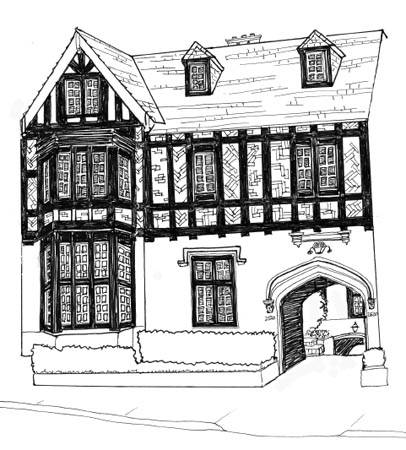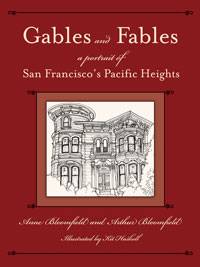An Abstract Expressionist Lived Here
Historical Essay
by Anne Bloomfield and Arthur Bloomfield
2520 Divisadero, one of a pair of Tudor Revival houses nestled against each other, was built in 1933.
Illustration: Kit Haskell
No, 2520 Divisadero doesn’t seem like your typical house for an Abstract Expressionist, and in early middle age feisty Nell Sinton did leave this capitalists’ corner of Pacific Heights for Russian Hill—not for a funky studio by any means but to a neighborhood which with its curving corniches, conspicuous Arts and Crafts presence, an art school complete with Lombardian tower and cloister-type patio, and a house, too, that belonged to Mrs. Robert Louis Stevenson, has a somewhat more Bohemian flavor than its august neighbor to the west. Upper Bohemian of course.
Nell Sinton had already studied at that Russian Hill school, the California School of Fine Arts (now the Art Institute) before settling into her posh digs on Divisadero. It was only when she sold the house in 1955 that she began the work for which she was most noted.
In 1981 Mills College held a thirty-year Nell Sinton retrospective exhibition dividing her still-active career into several periods. The earliest works, from the 1940s, were naïve and charming interiors and landscapes. From the 1960s came the Abstract Expressionist paintings, voluptuous, “loosely formal” compositions exploding in riots of color and exposing, said Art Week, Sinton-the-poet at her best. Next came her figurative phase, somewhat in the manner of David Park and Richard Diebenkorn. Then there were small mixed-media constructions and, in the late 1970s, a Garden Party series thick with social satire.
Not your generic Pacific Heights matron stuff!
And so, at age seventy, Nell Walter Sinton had refused to grow stale, working her way through new mediums and styles and telling an interviewer, “I find landscapes in human bodies and vice versa.” Coming full circle, but with new power, she had recently turned to buoyant watercolor studies reminiscent, superficially at least, of her painting from the 1940s.
And what of her husband, Stanley Sinton Jr., considered “one of the quiet stalwarts” of the city. As leader of SPUR, San Francisco Planning and Urban Research, he was at the center of the campaign for Proposition H which approved two thousand units of low-cost public housing in 1968, and three years later he spearheaded SPUR’s fight against the Alvin Duskin initiative to clamp a six-story height limit on new building.
The John Walter family was among the three dozen elite Jewish families who came to San Francisco in pioneer days and quickly made fortunes in clothing, dry goods, produce marketing, wood, paper, Alaskan development, etc. They all socialized together and, in a remarkable genealogical spaghetti tangle, frequently intermarried. Most of them had come from Bavaria, the town of Rechendorf for instance, which was home to the Hellman, Haas and Walter clans.
Reprinted from Gables and Fables: A Portrait of San Francisco’s Pacific Heights by Anne Bloomfield and Arthur Bloomfield. Illustrations by Kit Haskell. [1]
© 2007. Heyday Books, Berkeley, California.


